When I first started my product management journey, I often got stuck in discussions around what to do, who to serve, and how to prioritize time. Month after month, I argued with business stakeholders around the same topics.

At some points, people asked me so many questions that I felt like I was a meeting manager instead of a product manager. The following haunted me the most:
If any of these questions ring a bell to you, you may be suffering from a lack of a clear product strategy.
In this article, you will learn what a product strategy is, the challenges you might face creating one, and four templates to get you started.
Product strategy is a high-level product management and marketing plan that outlines what a team aims to accomplish with its product and how it will get there. The plan serves as a living document to guide decision making regarding the direction of the product.
A clear product strategy plan enables teams to focus and make daily decisions. This will allow your team to know what and what not to do, who to serve, and what success looks like.
Product strategy isn’t a plan you blindly follow. It’s a set of constraints defining how to conduct business. It doesn’t limit you, but instead guides you in the right direction.
The most difficult part of setting a product strategy is knowing where to start and what to use. If you try googling product strategy, you’ll find hundreds of posts about it. However, no single article will provide you with a foolproof template for success.
Part of product management involves seeing what works for others and adapting these formulas to your own team. So much depends on your particular use-case that I can’t say that one strategy or tool will always work, but I will share what works for me and hundreds of others in the field.
Although there’s no one-size-fits-all template for product strategy, I find that successful teams often utilize variations of the following four:
To develop an effective product strategy, you need to nail your product vision. Your vision is the big picture goal that you have for a product. You can think of this as where you want your product to go.
When you get the vision right, you put people on a mission. A great vision is inspiring, audacious, achievable, and focused.
To help you craft your product vision, start with some structure and then you can always riff off the ideas that you generate. A classic template is:
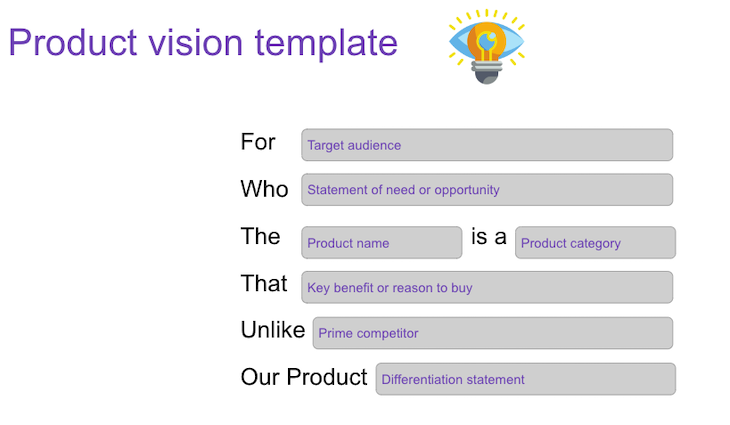
I like this format because it makes the characteristics clear and it provides guidance. From this, you will have a clear sense of who will interact with your product and how you will carve out a market niche.
You can use this template with your team to work towards a vision statement that accurately represents the direction of the product and its customer fit.
Product vision helps with direction, but you need more than that to provide enough guidance to your team. How do you set this correctly? This is where developing strategy comes into play now that you know what you want your product to accomplish.
There are many templates to help develop strategy, but I’d recommend Lean Canvas by Ash Maurya, Founder/CEO of Leanstack:
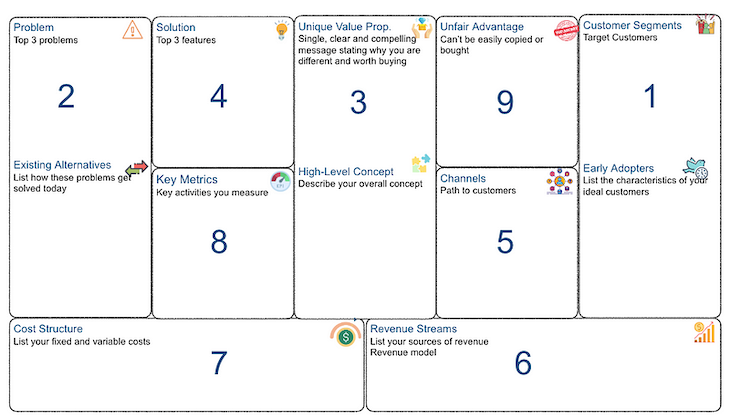
The Lean Canvas breaks down your product into individual boxes that allow you to arrive at a deeper understanding of your product, so that you know exactly what you need to accomplish. These boxes are
To fill out the Lean Canvas, you need to involve management, business stakeholders, and product leaders. Keep it simple, and continuously evolve it as you gain evidence from experiments. You can find the template here.
Alongside Lean Canvas, I like to run competitor analysis. Competitor analysis involves coming to an understanding of the strengths and weaknesses of rival products in your market. To do this, you need to know your competition and what you want to focus on differently.
Blue Ocean strategy developed an effective strategy for competitor analysis. It has four aspects:
To clarify, let’s compare a traditional bank with a digital one:
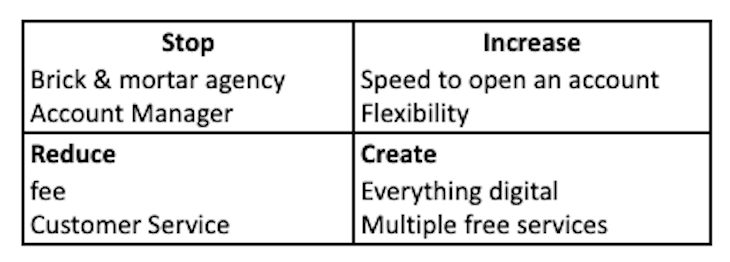
As you’ve defined what to stop, reduce, increase, and create. Define how you distribute your value curve. For each attribute, assign a value from zero to ten, where zero means it’s not in the product, and ten means it’s the best in the market:
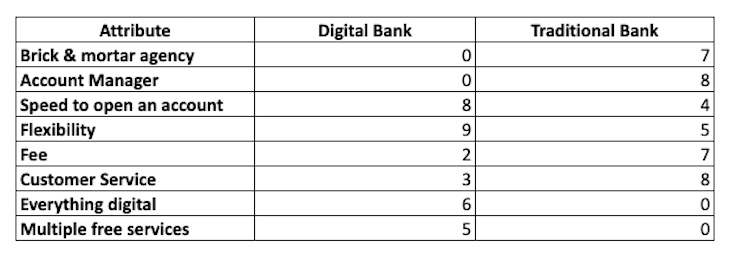
To illustrate your value curve, you can create a simple graph:
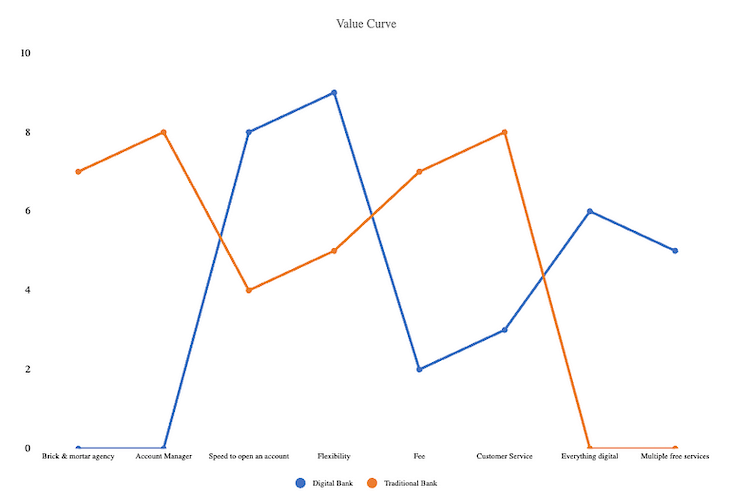
Creating a value curve allows you to clearly see where your product differentiates itself from its competitor. You can use this template with your team.
Once you have a clear understanding of your vision, strategy, and value, turn your attention towards creating a roadmap for your product. After experiencing different roadmaps, I came up with one that worked the best for me. Let me share it with you:
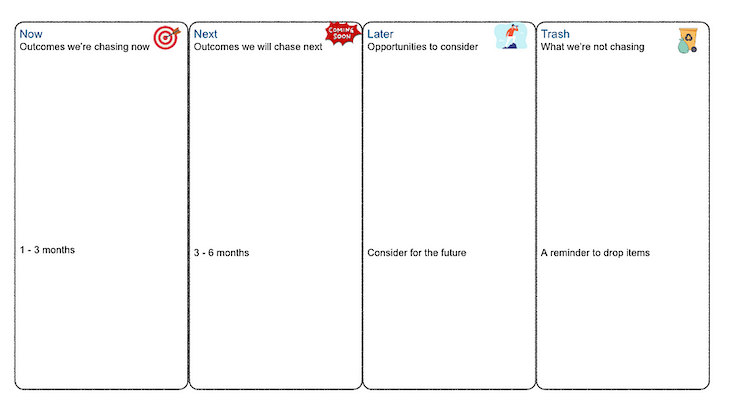
This format is simple, and it utilizes the following:
Let’s move from abstraction to something concrete. The following represents an example of a roadmap using this template:

This is a real roadmap from one of the companies I worked for. Back then, I struggled to balance customer lifetime value and acquisition cost.
After working with my team, we argued on the following roadmap answers:
You can use this template with your own team to create a successful roadmap.
Effective product strategy allows teams to generate value products. Without meaningful strategy, teams get lost and fail to deliver successful products.
By leveraging vision, strategy, value, and roadmap templates, you can ensure that your team remains on track to deliver on its objectives.
LogRocket identifies friction points in the user experience so you can make informed decisions about product and design changes that must happen to hit your goals.
With LogRocket, you can understand the scope of the issues affecting your product and prioritize the changes that need to be made. LogRocket simplifies workflows by allowing Engineering, Product, UX, and Design teams to work from the same data as you, eliminating any confusion about what needs to be done.
Get your teams on the same page — try LogRocket today.

Christina Valls shares how her teams have transformed digital experiences at Cedars-Sinai, including building a digital scheduling platform.

Red-teaming reveals how AI fails at scale. Learn to embed adversarial testing into your sprints before your product becomes a headline.

Cory Bishop talks about the role of human-centered design and empathy in Bubble’s no-code AI development product.

Learn how to reduce mobile friction, boost UX, and drive engagement with practical, data-driven strategies for product managers.